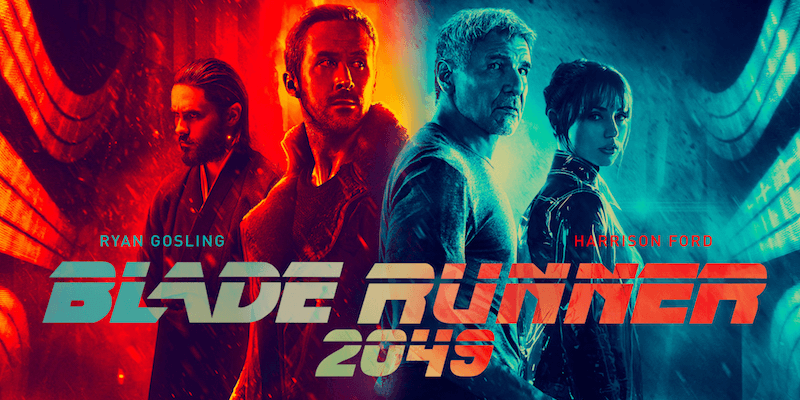by Andrew Emge
Take an in-depth look at the creation process of Blade Runner 2049’s bold sonic universe with supervising sound editor Mark Mangini.
The sound of Blade Runner 2049 is striking. Even non-soundfolk are likely to recognize the crucial role it plays throughout the expansive follow-up to Ridley Scott’s 1982 sci-fi cult classic. Artfully sweeping from immersive to hyper-focused to nearly silent, the film’s stellar sound propels the viewer through a dystopian world feeling at once futuristic yet jarringly human.
Leading the sound team was supervising sound editor Mark Mangini: winner of the 2016 Best Sound Editing Academy Award for Mad Max: Fury Road, and renowned audio post veteran with over 100 film credits across several decades. Since partnering with Mangini earlier this year to develop his personal sound library, The Odyssey Collection, the team at Pro Sound Effects has become quite familiar and increasingly fascinated with his expert, philosophical approach as a sound artist.
Read our conversation with Mangini below for an exclusive in-depth look at his team’s brilliant work on the highly-anticipated film including the commanding use of dynamic range, creating major sonic elements, leveraging his sound library, and why science fiction is his favorite film medium to work in.
Warning: Contains spoilers.
Images from film courtesy of Warner Bros.
What was director Denis Villeneuve’s vision for the sound of Blade Runner 2049, and how did you work with that direction?
Denis was very clear that we wanted our film to “feel” like the first Blade Runner, but we didn't want to copy it in any way. We felt that if we could deconstruct the sonic language used in the first film, we could use that as the entrance point, a way to find a language for our film. I was able to listen to the stems (separations of Dialog, Music and Effects) from the first film, and the first revelation was that Vangelis made a variety of musical-like ambiences that some of us might have credited to the sound designer, and ambient like music that we might have credited to the composer. We discovered that part of Ridley's aesthetic was to immerse the audience in a mood through the use of music and sound design without it ever being clear which was which.
That gave us a direction, a first goal: to blur the lines - to create sound and sonic atmospheres that were musical, tonal, or moody - without having melody... or feeling like score. One of Denis’ early exhortations to (sound designer) Theo Green and myself was, "I want you to compose with sound.” I’ve never asked but I imagine he gave very similar instructions to (composers) Ben Wallfisch and Hans Zimmer in creating the score; design sound with music. I think what we end up with is a really seamless blend of a movie that has a Soundtrack, with a capital S - and you don’t know who did what...and it doesn’t really matter. It allows the audience to more easily focus on the movie, because they’re less aware of the components.
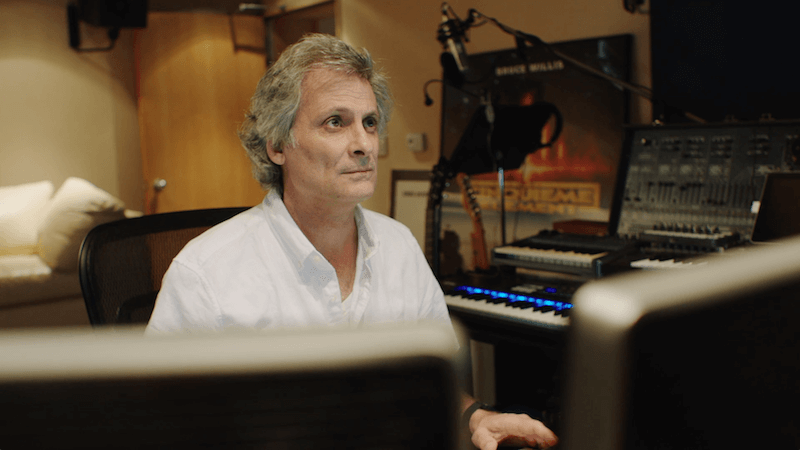 Mangini in his studio
Mangini in his studio
How did you approach creating and implementing these sounds that blurred the lines?
For months, Theo and I created very musical atmospheres that started life as chimes, bells, distorted guitars, vocal sounds and chants from lost languages… a variety of things that had a musical quality without being melodic. We placed these sounds throughout the film. In virtually every scene, if you listen, there’s melodic content, musical content, designed content that is always imbuing a scene with an ambience to communicate or augment mood. Much as had been done in the first film.
I've seen the master tapes from Vangelis's studio and I know that he made a variety of improvised atmospheres and we felt we were following in his footsteps. These atmospheres then, as now, were not marked on the recording tapes as to what scene they were for. So, too, did we improvise sounds without regard for what we would do with them.
If I was moved to create a certain sonic texture because I liked it and it had an emotional content, I would just create it, even though I didn't have a specific idea of how it would be used. Sometimes it wasn't apparent until I would go to the edit room and play these sounds for Denis and (film editor) Joe Walker. Often, they would have an immediate emotional response and say, "Oh, that's really good for K's nightmare!" We were given a great deal of free rein to invent, create, and improvise.
“One of the first things Denis said to me was, ‘Do not be afraid to not be logical.’”
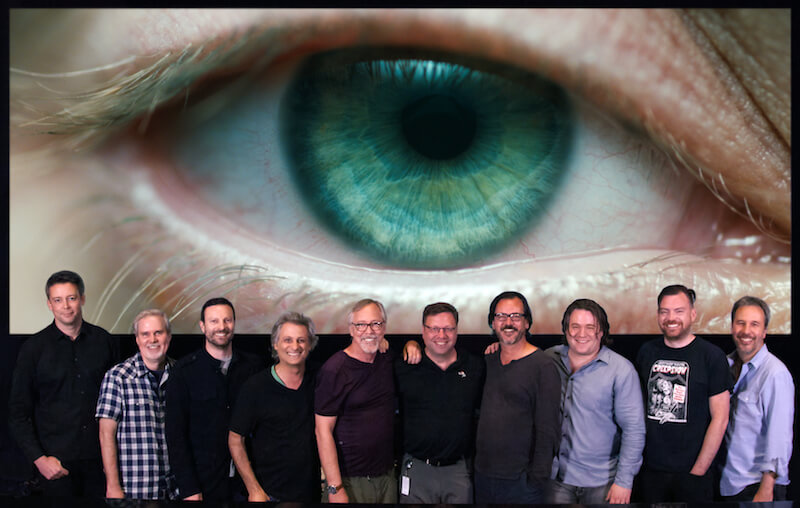 Blade Runner 2049 post sound crew
Blade Runner 2049 post sound crewInteresting how the process was very independent and collaborative at the same time.
Denis is an amazing director. He's very sure of what he wants, and yet, he's one of the great collaborators of the world. He gives us, as artists, a great deal of leeway and really encouraged us to take risks. In fact, one of the first things Denis said to me was, "Do not be afraid to not be logical." I put that on a sticky on my computer desktop.
That can be frightening because you're putting yourself on the line which tends to modulate the kind of risks that you take. I think all of us, as sound artists, share a similar concern. But there was never any embarrassment in not succeeding. Denis understood the kind of way-finding process that we were embarking on; of experimentation, success, and failure, and he supported that. In that process he would make very clear his aesthetic, giving us as a lot of free rein to create.
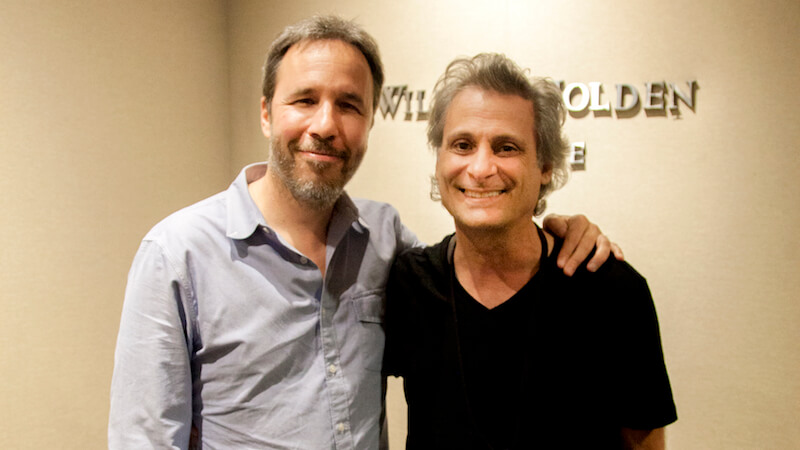 Denis Villeneuve and Mark Mangini
Denis Villeneuve and Mark ManginiDid the goal of maintaining sonic ties to the first film help or hinder your process?
Well, the first film is so iconic. I would be lying if I didn't admit to some amount of anxiety about doing it justice. In the early months I felt a lot of panic and terror to not only please the fanbase, but Ridley...and Denis, of course. It's such a beloved film. But we achieved a satisfying result because we understood that, and we let go of it and recognized that our job was to take risks and create. We just moved passed it. We were never paralyzed by that idea. You can only do the best you can do.
Sometimes you have to channel that stuff. If you can channel your anxiety into a scene where you want to create anxiety, and you're already in the mindset, use what you've been given. Classic method acting stuff. One of the many lessons I've learned in my career is that sometimes there's no inspiration and the only way to get it is to just do the work. Even when you don't feel anything, engrossing yourself in the world will create an epiphany at some point.
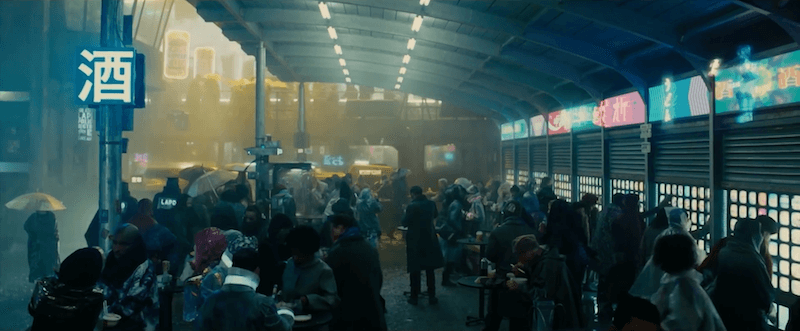
How would you describe the unique sonic universe that you achieved?
It's immersive if nothing else. Part of the language, too, is trying to be consistent with the storytelling. The first film takes place in a crushingly over populated Los Angeles. In our film, taking place 30 years later, Los Angeles is even more crowded, dense, and oppressive. So a big part of our sonic goal was to be immersive so the audience felt surrounded, oppressed by the sound of an oppressive culture. That was an emotional and narrative goal.
Given the value and ubiquity of immersive sound formats, we thought it valuable to exploit them to constantly surround the audience with voices, futuristic traffic, advertising solicitations etc. Anytime the film went outside we tried to amp up the oppression by feeling a bigger crush of people and the sounds of the environments they were in.
But I think Denis very rightly made a movie that also highlights silence. That's what gives our movie, I think, a really unique character and such dynamics. We step outside of that oppressive world a lot - not only to good storytelling effect, but for good sonic effect. The ear needs a rest. It needs to be like a roller coaster. You need big louds, and you need real quiet quiets. I think we achieved some real success with our quiets.
“In science fiction, we have to figure out a way to suspend disbelief by creating sounds that no one’s ever heard before.”
Can you discuss your use of silence and dynamic range?
In an early conversation I had with Denis and Joe Walker, they voiced their desire to achieve great quiet, not the loud. They knew that the loud is often the easiest thing to do. That's not a tough assignment for a sound designer, to do big. I think doing “ little” is tougher, because we have this tendency to pile on. For example, the first scene Joe showed me was the first draft of K's walk in the desert and through the casino. He told me they wanted really, really quiet winds. I told him that my sense of silence and the way to achieve it was, first of all, you can't do absolute silence. You can't go to all zeros on the digital meter, because then the audience thinks there's something wrong with the track.
So you need the simplest essence of presence; the audio version of nothingness - I call it the Seinfeld tone. It's a sound of nothing, but it's actually something, but you don't really hear it; you feel it, so that you know there's a presence, but nothing's moving. Then you interrupt it, because it's in the interruptions that the brain notices it’s been really quiet for a long time. But you don't register that until you hear a very, very small sound interrupting the silence. We use that really effectively in the desert, and even more effectively in the walk in the casino.
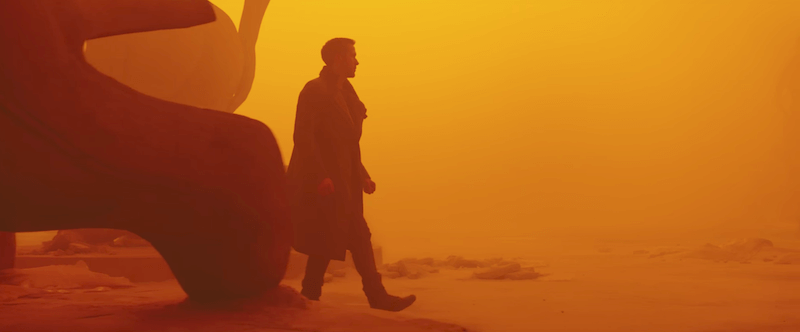
Did you record “Seinfeld tone” specifically for this film?
The Seinfeld tone was a 7 channel air I made in my living room late one night. Just air, no traffic. Carefully edited and mastered to be very plain vanilla. The interruptions that define the silences were done in my friend Charlie Campagna’s studio. He's got a really big, dead, quiet live room, and four of us planted ourselves in the corners of the studio. We would randomly drop little bits of debris - like grains of sand and dust as well as twist furniture to get subtle creaks, over the course of 10 minutes, to create the sound that you hear late at night when you're in bed and it's really quiet. To get those miniature sounds one hears in the house when it creak a little bit or contracts from cooling off. That became a really valuable track to help create this idea of interrupting silence to create the feeling of silence.
Were these silent moments designated from the beginning?
As a director, Denis has a really austere aesthetic. He's all about stripping it down only to what you need. We learned that very quickly in our build of the design and music. That walk in the orange desert where he’s seeing all the crumbled statues in Las Vegas, in fact, was a beautiful moment that underlines what a perceptive filmmaker he is and how simple the filmmaking process can be if you're open to it. That moment was planned as an important music cue to tell the story of the blackout, and the nuclear explosion that took out Las Vegas. Only music could carry that size and dramatic weight. To emphasize the introduction to that scene, I had made 7.1 sonic “booms,” inspired by the Vangelis drums that open the first Blade Runner. Ben Wallfisch had heard them there since the first temp mix and written a magnificent cue to incorporate them rhythmically.
That scene was working really beautifully until one day Denis wanted the booms even bigger. I hadn’t made them huge enough. So I asked (re-recording mixer) Ron Bartlett, who's also a really fine percussionist and musician, to record some drums at home to help sweeten the booms. When we were adding his new drums the next day, Denis heard them soloed for a brief moment and, on the spot said "Stop...what is that...that's the sound of that scene." It was so simple and eerily effective to just have these booms and absolute silence except for K’s footsteps walking in sand. It was just a great, simple decision by a director who knew when he heard something special, even if by accident, and wanted to use it despite contradicting the arc of the film up until that point.
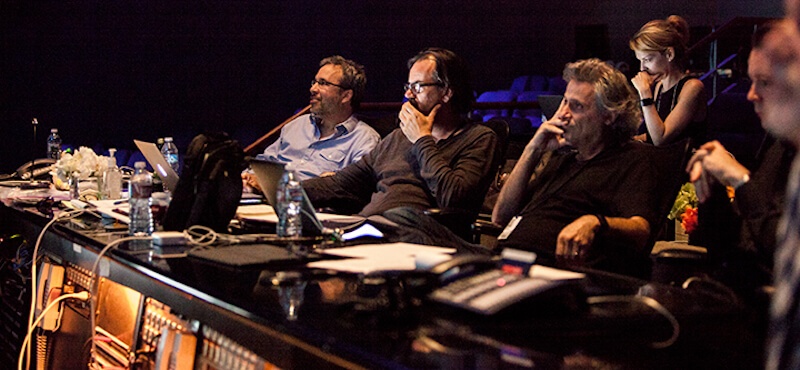 Denis, Joe, and Mark at the mix stage
Denis, Joe, and Mark at the mix stage“A big part of our sonic goal was to be immersive so the audience felt surrounded, oppressed by the sound of an oppressive culture.”
To what level did you collaborate with composers Ben Wallfisch and Hans Zimmer to integrate their bold, full-bodied score?
Ben and Hans came in later than usual on this film, at a point when a good deal of the sound design was already done. That's a credit to Denis and Joe Walker, because they put Theo Green and I on very early and gave us a long lead time to create and design. Going into final mix, they knew the movie they had sonically. This meant the final mix could be a simple process for the director to just enjoy making the important decisions: featuring dialogue here, or pulling back the sound effects there. There was none of the usual micromanagement stuff.
We were so in the pocket by the time that Ben came on, he knew that whatever was in the mix was approved by Denis, so he was going to have to write to complement it, work around it, or in some cases do better than it. Because of that, we never had the traditional battles between sound design and music cues. Ben recognized that we were working in this kind of Musique Concrète compositional style, so all of his cues dovetailed beautifully with what we did, and vice versa. It was just this beautiful, happy marriage that Denis orchestrated. But, in fact, Ben and I had very little interaction other than to show up at the mix and admire each other's work.
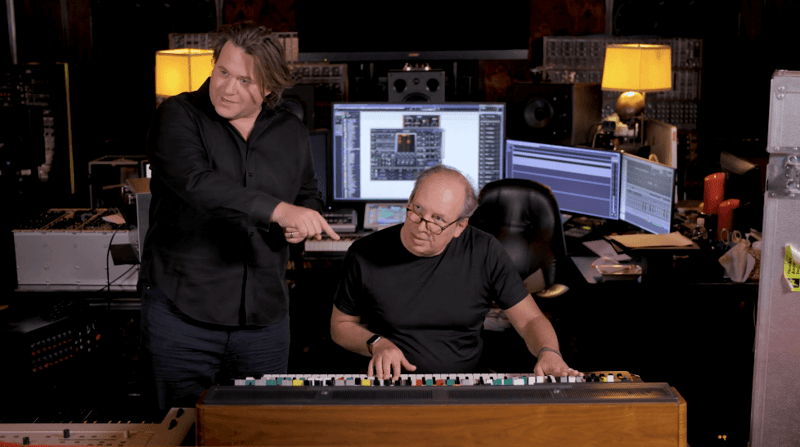 Composers Ben Wallfisch & Hans Zimmer - Photo courtesy of ASG Records & Epic Records
Composers Ben Wallfisch & Hans Zimmer - Photo courtesy of ASG Records & Epic Records How did mixing in Atmos influence your approach to design and editorial?
When (dialogue & music re-recording mixer) Ron Bartlett and (FX re-recording mixer) Doug Hemphill and I met with Denis to talk about how we would approach the movie, we told him we wanted to do a native Atmos mix - meaning we were mixing in Atmos from day one of mixing, not up-mixing to Atmos after the fact. He was in favor but thinks it’s bad storytelling to have a lot of distracting sounds in the surrounds. So we were very cautious and judicious about the bits that we would put in the surrounds.
From a sound effects standpoint, we used very few objects, and we very rarely flew something around the theater to distract the audience. Doug Hemphill did a gorgeous job of filling the theater without ever creating a distraction with “objects” flying about. There are a couple moments where the spinners fly by, and Denis loved those, but mostly what Doug did with the surround was full immersion with atmospheres; things that put you in the middle of an environment, and you were never aware of Dolby Atmos, but it augmented the experience by creating a higher level of reality.
Interestingly, it was the score that used the objects the most, and to great effect. Ben very smartly stemmed out his cues very wide, and Ron Bartlett would put them in the 36 speakers around the theater in a unique way, so you always felt like you were in the midst of the music rather than the music coming at you from the front screen. That also allowed us to be very powerful with sound effects front-screen, because a lot of the music energy was being generated from back in the theater. That creates a lot of sonic clarity so your big, important impact moments with sound effects can really play without fighting for the same speaker cone.
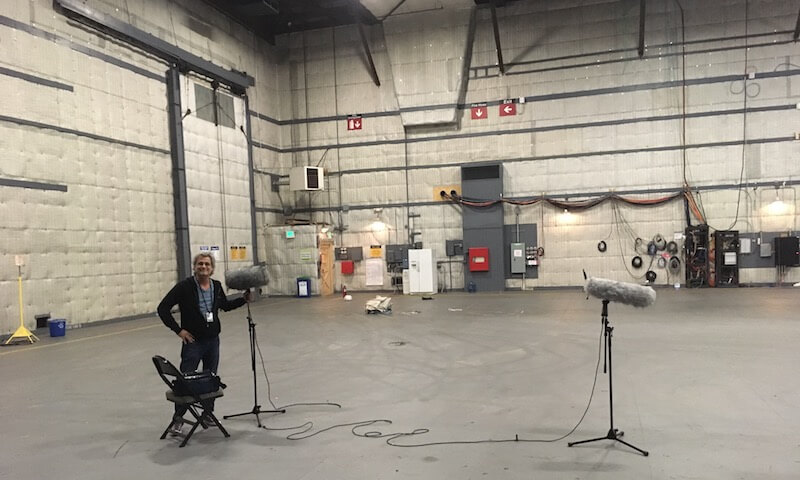 Mangini “worldizing” voices in a sound stage
Mangini “worldizing” voices in a sound stageWhat are some other recording elements and sessions that were most useful?
We had great fun recording rattles for the spinners. K's spinner was always meant to be kind of thrown together with spare parts that could be found, and not in such good repair. So Charlie Campagna, again, had this great idea to use the interior of my wife's old Honda Element to get a very natural acoustic space that felt like the cockpit interior of a spaceship. We drove low frequency information into the interior of the car to excite it, and threw in metal and plastic objects, and captured all of those cool rattles in surround.
I was unbelievably blessed this past spring with a once-in-a-century set of rains. This is southern California, we never get rain, and we got monsoon rains like we haven't had in 100 years. I was worried because there's so much rain in the movie, and I wanted it to be really immersive and atmospheric. One of the things I learned in researching rain is that most people record rain by pointing a microphone at it, but I wanted to be in it. So I built an eight-channel microphone rig and a special rain protector, so that the rain wouldn't fall on the mics but you'd hear the rain falling 360 degrees around the mics. Every night that it rained, for two months, I went out at 2:00 in the morning when the traffic died down and recorded these really great 7.0 rains. That's a big part of the atmospheric effect we were after, such as the rooftop with Joi.
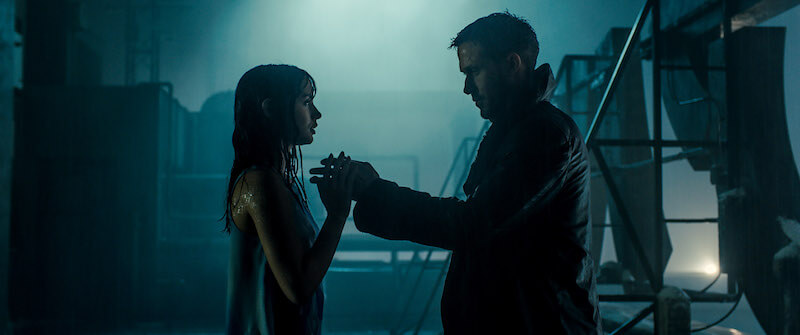
We recorded spinner tops, drills, drones, bells, chimes, bees, moviolas, pasta sauce... It's a long list of the recordings we made just trying to find sound that was going to be a useful starting point. This film is 99% organic and acoustic sound. One of the things that Denis and I were very clear on is that we didn't want it to sound like Flash Gordon. We didn't want those theremin-like, synthy kinds of tones, we didn't want lots of electronic beeps on screen. We tried to keep it real clean and make all of that stuff start life as an organic, acoustic sound. So we were constantly recording.
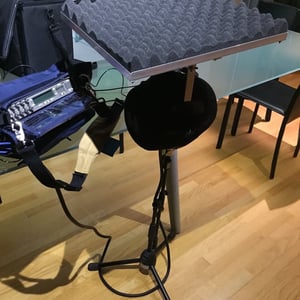 |
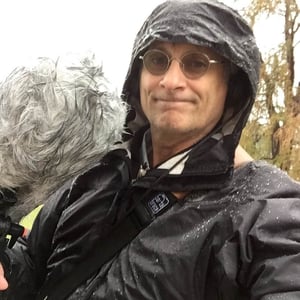 |
| Custom rain shield | Recording rain... in the rain |
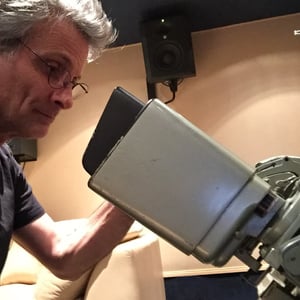 |
 |
| Recording moviolas | Bees on the mic |
The Foley was amazing throughout - very full and realistic. The footsteps on the metal stairs especially struck me.
Props to Andy Malcolm and Goro Koyama. These are two immensely talented Foley artists who work out of Toronto, Canada, and are two of the few who do real acoustic Foley. They cast locations, and they go out, like they did with those metal stairs, and find locations that have the real thing so that there's a believability level to everything that they do, and it's acoustic. And even in their traditional studio work, they don't walk on a two-foot square piece of parquet with a microphone close on their feet. There’s a lot of ambience and movement in their tracks.
A good portion of the Foley was done through casting locations and recording it like it was production, with a boom pole, and walking away from the microphone to the same distance the characters walk away so you create this level of realism that traditional Foley doesn't have. Those staircases you mentioned, that's considered a design moment, and yet it's nothing more than Andy and Goro running around on stairs with reverb on it. But it's a very evocative sound.
Speaking of reverb, the film had an amazing sense of space. Can you tell me about the reverbs you used?
Ron Bartlett and I have been beta testing this new immersive reverb called DSpatial Reverb. It's an algorithm-based impulse response reverb. It doesn’t use recordings of impulse responses; it uses an algorithm to create them based on user parameters. But in so doing, you can have up to 64 channels of decorrelated reverb return.
We thought this was really exciting for the really big interior spaces like Wallace's office - that watery room with the really beautiful rippley lights on the wall. It allowed us to feed dialogue or sound effects into DSpatial Reverb, and then place 36 channels of decorrelated reverb return into every one of the Atmos speakers as objects. This creates what I think is a very believable immersive environment, rather than a mono send to a two-channel reverb or even a 5 or 7 channel reverb. This gives you the closest approximation to what the real world sounds like acoustically.
On the effects side, we used a lot of PhoenixVerb surround and Altiverb for specific spaces. I believe Ben Wallfisch used R2 for the reverbs on the score. The reverb work is really Ron Barlett and Doug Hemphill's bailiwick. They did a lot of the really cool reverb work.
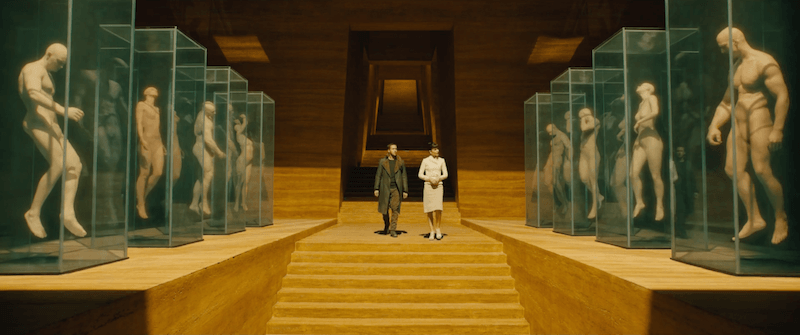
What were some other audio tools that you relied on to create the soundtrack?
I'm a bigger believer in finding the right sound in the first place, because plugins most often kind of electronify sounds, and we wanted things to be really organic. So I don't use a lot of plugins. But I'd say the two I used the most were Eventide's Blackhole which is a gorgeous, pitch-shifted reverb that makes the reverb tail swimmy and move around their pitch center. I bathed lots of stuff in that. I also used Kontakt a lot as my sampler, but it was always loading in acoustic recordings of things I made to sort of perform in a different way.
Other than that, my stock and trade is the traditional stuff: I play things backwards, I speed them up, I slow them down. I heavily leverage my library to find new sounds that I didn't think of initially. My process is always to decontextualize. Find a sound that sounds like the thing you're looking at, but has nothing to do with it, and then the audience will buy into it.
How else did you use your sound library in the film?
Though we had a really smart budget, and a real amount of time to do the film, you simply can't record everything. Some things you just can't find. We created and designed about 2,600 new elements, but even still, there is a percentage of the film that relies on library sound. If nothing else, the library would be the beginnings of my creative process. I would hear a sound that inspired me, and if it didn’t quite work, then I would either go and record that thing or manipulate it to my own ends.
We had to create so many sounds that no one's ever heard before, and it’s sometimes crazy - trying to make the sound “that no one has ever heard before.” So I do this thing where, if I'm stuck on a sound, I use the library as kind of a creative catalyst. I'll throw my hands on the keyboard and type in a series of letters that could start with F, or Z, or U, or whatever, and then hit return. Whatever comes back, I force myself to figure out a way that those sounds could be relevant to the problem I'm trying to solve. It's the ability to connect disparate ideas that sometimes cues creativity for me.
Create beyond your imagination with The Odyssey Collection
Aside from being a creative catalyst, did any sounds from your library make the final cut?
One of my early projects was to create a signature sound for the doors on K's spinner, because he's always getting in and out of the thing. I didn't record anything for that. Those were all sounds I'd cobbled together from hydraulic lifts, lift gate motors, and airplane cockpits closing etc. Those were all library sounds that were put together in a way that made it sound believable.
Again, Denis didn't want any kind of synthy sounds, nothing overly servo-motor sounding either. I had to go through four or five iterations of the spinner door before we hit upon success. The main motor component is a cat o' nine tail, a bull roarer as we call it, spinning around. That created that “vuh vuh vuh vuh...” but it's just a constant modulating buzzing. It took a lot of work to craft it into the spinner landing, or taking off, or passing by quickly. But that started with a bull roarer that Theo had recorded, but then masterfully crafted to picture by (sound effects editor) Chris Aud.
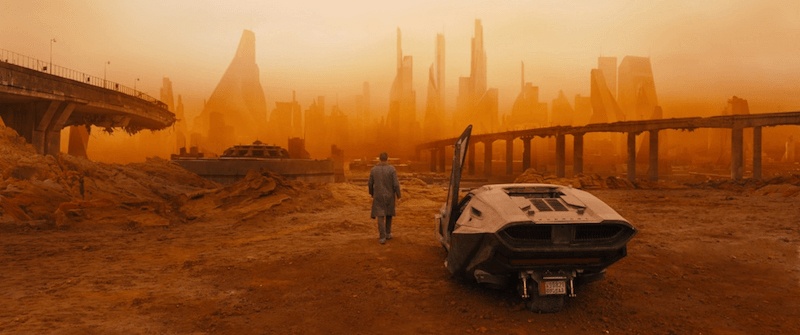
Do you have a favorite sound from the film?
One of my favorite sounds in the movie is the sound we made for K's blaster. Denis didn't want a science-fictiony laser pistol “pew pew” kind of thing. I started with the sound of a Barrett 50 cal that I recorded which is this giant sniper rifle. I just wanted the sound of a big, real gun, but it wasn't quite right. Then Theo sent over this Roland 909 kick drum sound processed to really boom, and that's all it was. It's just two sounds. It's really simple and really effective because of it. Sound editor and designer friends are gobsmacked by this saying things like, "Are you kidding me? Two channels? I have to use 64 to make a big sound like that!"
Another favorite of Denis's was one of the first things I made. I stumbled across a sound in my library, in fact, of a Tibetan long horn. I loved the sound of it; it reminded me of a sound in the first film. So I just slowed it down and put a bunch of reverb on it and played it for Denis. He fell in love with it and decided it was the sound of the off-world transport. And anytime we were outside, if he had an excuse, or we thought the energy was flagging, he'd say, "Mark, put in that big foghorn sound."
“You need the simplest essence of presence; the audio version of nothingness – I call it the Seinfeld tone…Then you interrupt it, because it’s in the interruptions that the brain notices it’s been really quiet for a long time."
How about your favorite moment for the mix?
One favorite is K's walk through the casino for a number of reasons. One, it's a really quiet scene, and we do really gorgeous, simple things. Doug Hemphill is a master mixer of simplicity and taste. The Foley there is super accurate and tasty, never overplayed.
I made this track of musical bells that Denis loved that I called “K's Journey of Discovery,” and it undergirds that entire walk until he meets Deckard. Ben gave me a very high compliment - he thinks it's just the sound of the Blade Runner universe. It has this haunting loneliness to it, and it was a very brave choice for Denis to lean on that and not a cue. K is just walking around, and there's no action. Most film directors would hedge their bets by putting a cue there to tell the audience what to feel.
Then, when he gets to what we call the Hologram Fun House where he walks into that showroom with the projections of Marilyn Monroe, Liberace, and the dancers - Theo designed that entire piece. All the sounds of those hologram machines malfunctioning, flashing, turning on and off, and the short bursts of music and sound that would come from the speakers as if this thing hasn't worked in 30 years. It's a contrast within frames from absolute quiet to a giant jolt of sound. I think that's such a cool scene.
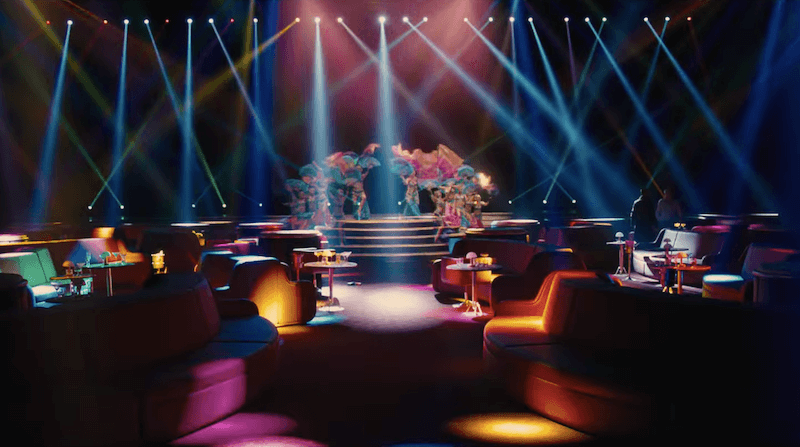
I’d love to hear your approach for a few specific moments in the film. What was the process like for the sound of the Sea Wall fight scene?
The Sea Wall fight was probably the scene we spent the most time on, and it's probably the one scene we'd all love to have more time on. It was one of the few design areas of the film that we didn't really nail early on, and were continuing to work on late into the mix, including Ben's score. (Sound editor) Lee Gilmore spent weeks building and editing all the sound fx components for that scene and laid it out beautifully. Ben, too, had built one of his most impressive and memorable musical moments. The Sea Wall was one of the few areas that we saw, visually, so late that we couldn’t really pre-build it and have a sense of what Ben and I were going to do.
Yet, the Sea Wall was where Denis got to really play in the mix room and craft the ins and outs of music and sound effects. We played a great deal with where sound effects would take over and where music would take over, and what made those moments.
(Sound effects recordist) Eric Potter recorded a variety of real sea walls as a starting point, so we'd get that crashing surf component, and it would feel very real, and recorded it four-channel so you could sort of drape it around the room. Lee built all the wave and water components crashing on the spinner and on the shore as well as the above water and underwater stuff.
We talked a lot about loudness in that scene and made many passes where we would nip and tuck. We didn't want to be overbearing with loudness, so we were very sensitive to that, and we spent hours deciding on the wave crashes and playing the balance of music and sound effects.
We did have some fun with Luv's underwater death. I didn't want that to be ADR that we put some filter on, so we brought an actress into Ron Bartlett’s jacuzzi and recorded her screaming underwater with hydrophones. That gave a level of believability since they didn't record that underwater in production, so we needed all that struggling and screaming stuff. I tried it myself in my bathtub and almost drowned. I wouldn't recommend recording underwater alone.
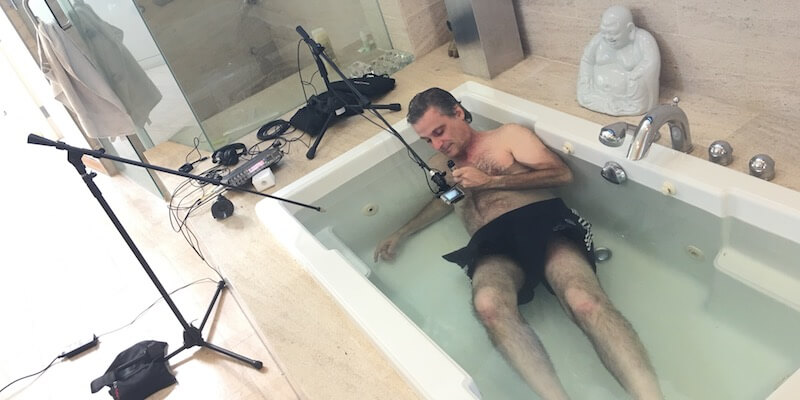 Mangini recording underwater screams
Mangini recording underwater screamsOne challenge, since it’s a little confusing visually, was selling the idea that the surf is coming in and moving the spinner further out to sea, to imply that it's going to fall off the edge of the seawall and sink into the ocean. We recorded a lot of elements for metal scraping on concrete, so we were very aware of these scraping sounds every time that they moved and lurched to sell that idea of the precarious position it was in.
We also made wave crashes on a metal shell so you feel like, at any minute, these powerful waves could crush the spinner’s metal structure. Then we made some underwater ambiences. Lee Gilmore made several and edited all of the sounds for that sequence including these very clever submersion and emerging sounds. So you'd be in this murky underwater atmosphere, and then he made these frequency sweeps when the camera would bob above and below water. So it wasn't just fading between above and below water, but we were putting action and momentum on those sounds with these dynamic filter sweeps. It was really effective.
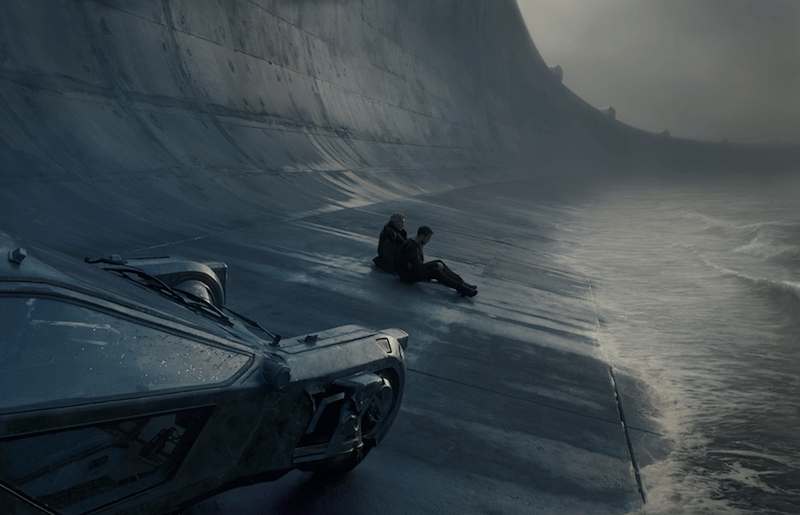
How did you create the sound for K’s crash landing in the Trash Mesa scene?
That was another instance of Denis’ bold approach. That had always been covered with a big cue as the lightning hits the kite and he loses electricity and avionics and crash lands. In a moment when Ron or Doug muted the music to isolate something in the mix, Denis heard a couple of sounds that we had made. One was this sound I made of the spinner plummeting to Earth with no engines - reminiscent of a Mitsubishi Zero dive bombing an aircraft carrier. I wanted it to feel out of control, like he's not going to pull out of this dive. So Denis really liked that sound and made the decision to pull the music from the time K starts to descend.
Then when the spinner hits the ground it's a cacophony of metal crashes that we staged at a junkyard with Eric Potter and Ezra Dweck. We went to a guy who buys and sells scrap metal and keeps it in big piles. We had him take a tractor and plow through these stacks of metal objects just like you see the spinner do in the movie, so you hear an impact preceding pieces of debris flying and falling off. It was really fun.
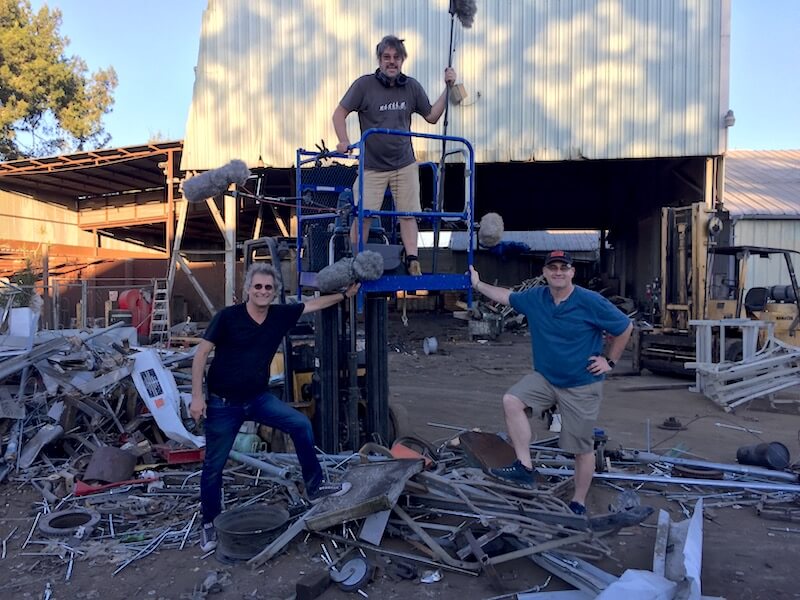
And how about building the tripwire explosion in the casino?
(Sound effects editor) Greg ten Bosch cut that all himself. I didn't want exterior explosions on an interior shot, so we pulled some sounds from my library. I can’t remember how many pounds of explosives - but we blew something up inside a room. He did a really lovely job of slowing, pitching, and tweaking those recordings.
I gave him very little direction on that other than it needs to be really quiet, and then you have to really shock the audience. He did a really terrific job of making those four explosions, and not letting the tails of each explosion overlap one another, so you got maximum impact from each. That's the sign of an expert. Most guys would cut four explosions and let the tails ring out all the way across. You lose detail that way. It’s an old, early Hollywood editor trick of cutting a couple of frames out between each gunshot in a western so that each gun reads as cleanly as it can.
SPOILER ALERT: Are there any Easter eggs that viewers should watch out for?
There are a bunch, but one that no one's gotten yet is that we were planting clues with sound. We give you clues that the child you see in the early flashbacks came from the orphanage he visits later. When K gets to the orphanage, the keeper of the orphanage blows this whistle to make the kids all stand up. It's two notes. I had this idea to plant that earlier in the film in all the flashbacks, so if you were really paying attention you'd get right away that this is where that kid came from.
We remade that whistle to follow the two note interval that Hans wrote for the Blade Runner theme so that it would work harmoniously with the score. Then we sprinkled it earlier in the film to give you this little insight if you were paying attention. We replaced the production sound of him blowing that whistle with a pitched version of these two notes and then placed that earlier in the movie.
 Recording windchimes in Mark’s studio
Recording windchimes in Mark’s studioAny final thoughts about your work on Blade Runner 2049?
What I love about this movie, and what I love about science fiction, is that we have this responsibility to do what we call "world building." This is a phrase that Theo Green came up with, and I think it really speaks to the unique challenge we have in science fiction. Traditional films take place in a world you recognize, where you're surrounded by sounds you’re familiar with: like dog barks, car skids, explosions, gunshots and many other sound tropes. In science fiction, we have to figure out a way to suspend disbelief by creating sounds that no one's ever heard before. Especially in a movie like this where none of it is real, we have to make the sound good enough that you absolutely believe that’s a blaster, that's a spinner, that's a seawall. I think the challenge is so immense, and what's so gratifying about working in science fiction is that we get to do this world building. It's my favorite medium to work in, I’ve got to say.

